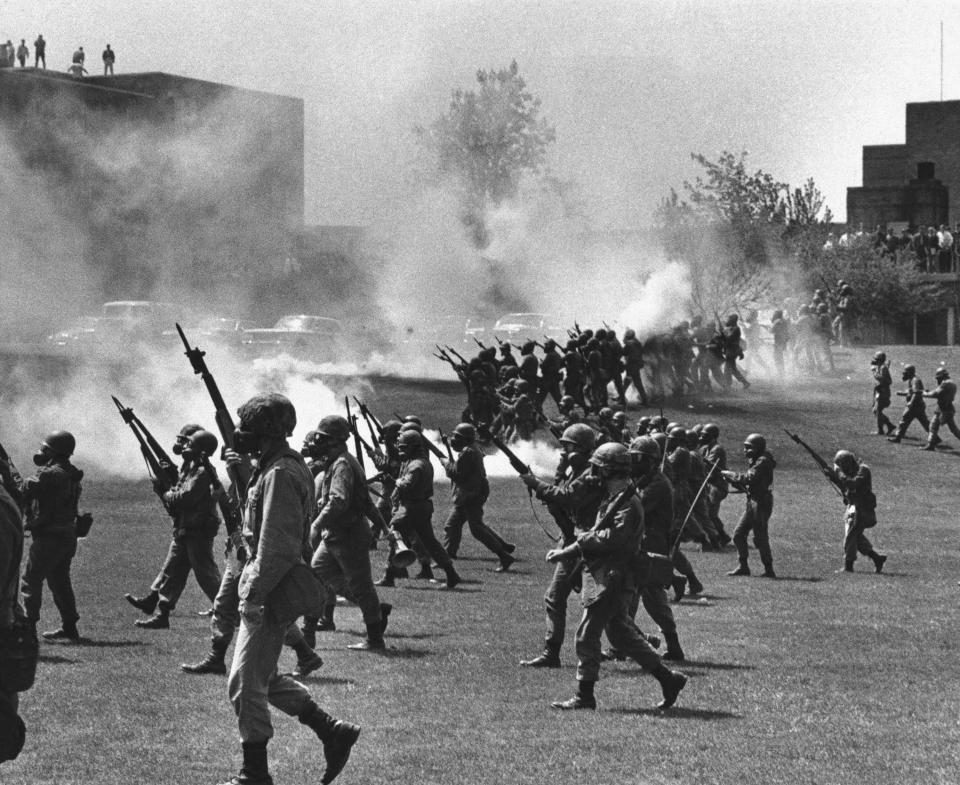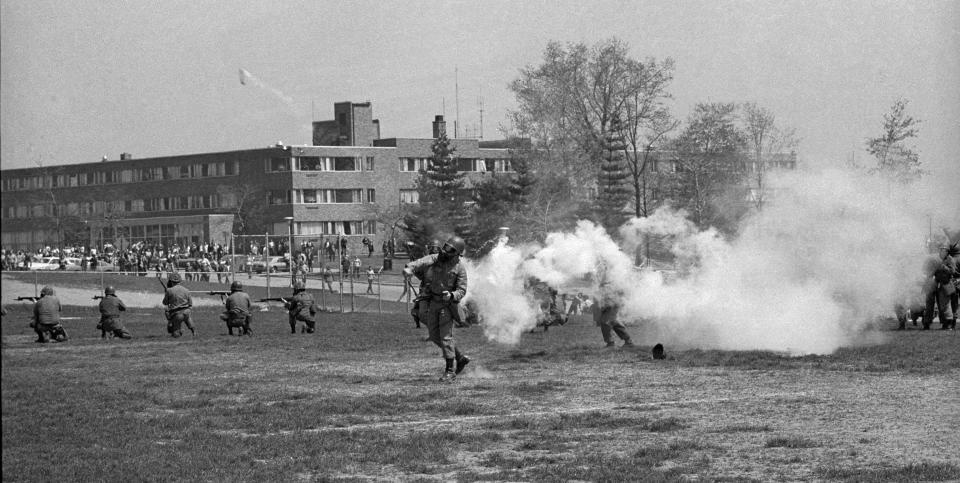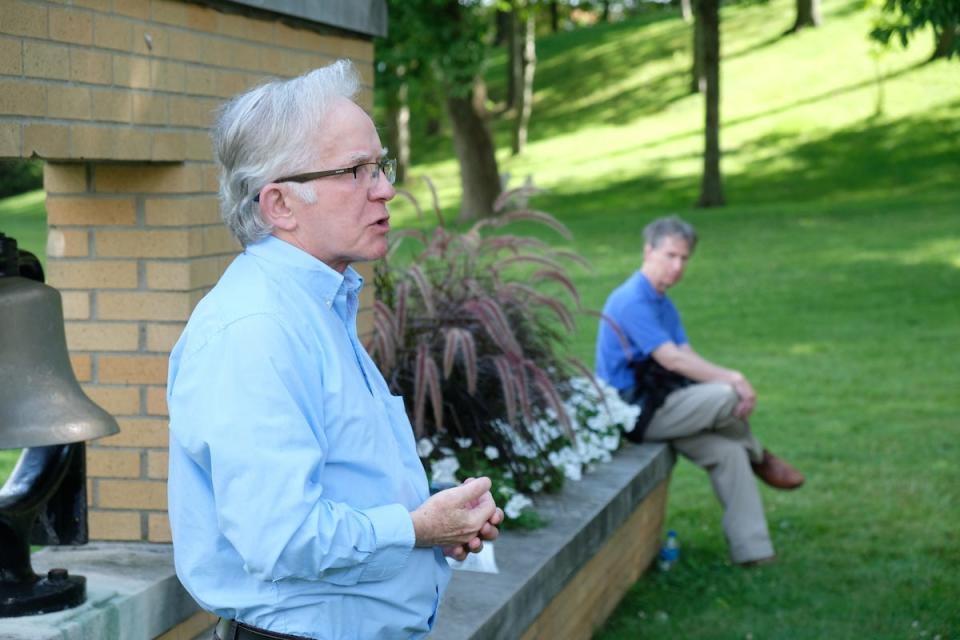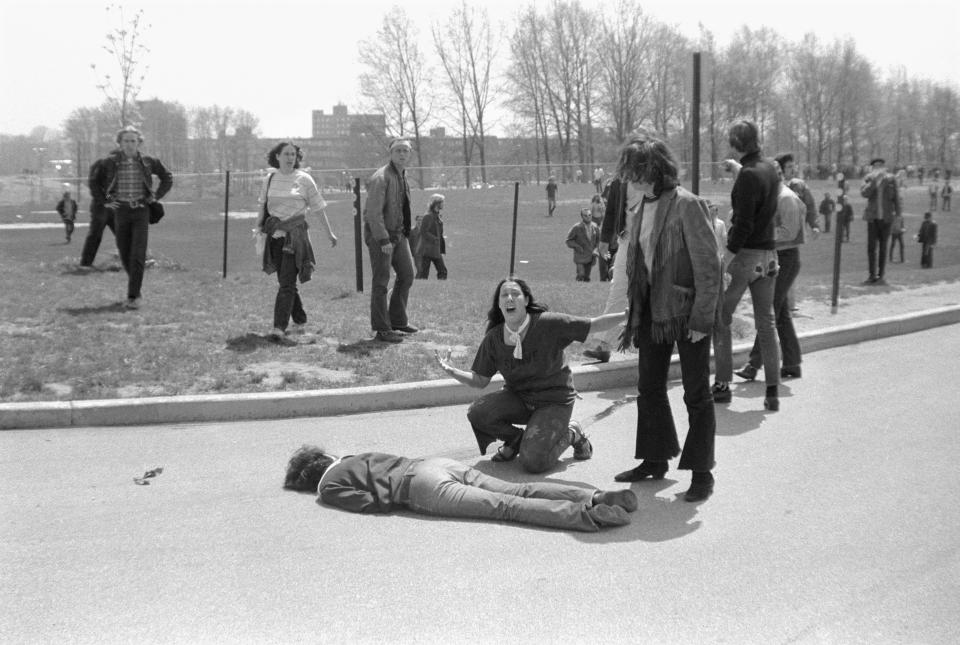This May 4, don't look away from the legacy of Kent State and four dead in Ohio
- Oops!Something went wrong.Please try again later.
- Oops!Something went wrong.Please try again later.
Every May 4, the ghosts return.
We see them in the images of students huddling around the campus Victory Bell on that sunny day in 1970. They are Ohio National Guard troops aiming their rifles at students minutes later. They are the students trying to save a wounded student, and the girl crying over the body of student Jeffrey Miller.
This is the legacy of anyone affiliated with Kent State. As it should be. To prevent future tragedies, remembrance is crucial.
A day before Ohio National Guard troops opened fire on students at Kent State, Gov. James Rhodes essentially gave his blessing, comparing the young protesters to Nazis and the Ku Klux Klan. “They’re worse than the brownshirts and the communist element and also the nightriders and the vigilantes,” he said in a speech at Kent on May 3, 1970. “They’re the worst type of people that we harbor in America.”

Rhodes was a Republican and considering a run for the U.S. Senate. He authorized a thousand Guard troops to swarm the campus.
A war that changed families and a campus forever
Three days before the governor's speech, President Richard Nixon had announced on national television that he was sending U.S. troops to Cambodia. This was a significant escalation of the Vietnam War, which was increasingly unpopular here at home.
Two years earlier, America’s most trusted newscaster, Walter Cronkite, had produced a documentary titled, “Report from Vietnam: Who, What, When, Where, Why?” For the first time, Cronkite ended his broadcast by offering his opinion about the war, based on his own reporting in Vietnam: “It seems now more certain than ever that the bloody experience of Vietnam is to end in a stalemate. ... It is increasingly clear to this reporter that the only rational way out then will be to negotiate, not as victors, but as an honorable people who lived up to their pledge to defend democracy, and did the best they could.”
Columnist Connie Schultz: Mother's Day is coming, so this is for single moms and the families they're building
President Lyndon Johnson’s administration never recovered. Johnson announced that he would not seek reelection, and Nixon defeated Vice President Hubert Humphrey for the presidency. After he announced the escalation into Cambodia, college campuses erupted with protests, including at Kent State in northeast Ohio.

Ohio National Guardsmen fired more than 60 shots in 13 seconds, killing four students and wounding nine.
One of those injured, Alan Canfora, died in 2021 at age 71. A founder of the May 4 Task Force, he devoted his life to making sure the university could never erase its violent history. Today, the May 4 walking tour of the campus includes markers where each of the students died. In 2017, the National Park Service designated the site as a National Historic Landmark.
Kent State shootings: A day of tragedy
Five months after the Vietnam War ended, on April 30, 1975, I arrived as a freshman at Kent State. I was a working-class kid, the first in my family to go to college. My home county, full of families like ours, had lost 26 boys in the Vietnam War. So many others served.
Only after I arrived at Kent State did I understand why people like me knew so many families forever changed by the war. I have always felt like an outsider, and I can now see this began with my time on that campus, where for the first time I met kids my age who didn’t know a single person who had served in Vietnam. Only some kids, I soon realized, grew up free to dream.
When you graduate from Kent State, you join the ranks of those who find themselves answering the same questions for years to come. Yes, that Kent State. Yes, where they killed those students. Yes, the Neil Young song.
When I was younger, I used to resent having to talk about this. It was an annoyance, explaining time and again that Kent State was more than a university where students are shot and killed. I’m embarrassed I ever thought that way, that I was ever this selfish. A university in denial (the school's May 4 Memorial was dedicated on the 20th anniversary) had helped me think this way.
Columnist Connie Schultz: How potholders got me thinking about racism, my father and the whitewashing of US history

For six years now, I’ve taught in the journalism school that launched my career all those many years ago. I wouldn’t have returned had the university not owned this history. Thank you, Alan Canfora.
People still ask those questions when they meet me, but my answers are different. Less cryptic. Yes, that Kent State, I tell them, but the “they” who opened fire was the government, the Ohio National Guard. Yes, students died, and they have names: Allison Krause, William Schroeder, Jeffrey Miller and Sandra Scheuer.
Menace behind official words, in Vietnam War and today
Most semesters, I required my students to watch the segment of Ken Burns’ PBS documentary "The Vietnam War" that focuses on the May 4 shootings at Kent State. They are the ages of the students on campus that day, including those who died. This is never lost on them, or me.
Columnist Connie Schultz: Why aren't all of us having nightmares about the next Jan. 6? Next time may succeed.

I used to show students only the part about what happened on our campus, but now we watch more of the segment, for context. This includes November 1969 footage of the half-million war protesters who showed up in Washington, D.C., where the White House was barricaded behind a wall of buses.
“President Nixon claimed he was too busy watching football on television to pay attention,” says narrator Peter Coyote, “but he did suggest that Army helicopters might be used to blow out the marchers’ candles.”
As my students have taught me, coming of age during the Trump administration and the Black Lives Matter movement means you recognize the menace behind those words. To be part of Kent State is to understand the danger.
This is our collective memory, as it should be.
This is our legacy, forevermore.
USA TODAY columnist Connie Schultz is a Pulitzer Prize winner whose novel, “The Daughters of Erietown,” is a New York Times bestseller. You can reach her at CSchultz@usatoday.com or on Twitter: @ConnieSchultz
You can read diverse opinions from our Board of Contributors and other writers on the Opinion front page, on Twitter @usatodayopinion and in our daily Opinion newsletter. To respond to a column, submit a comment to letters@usatoday.com.
This article originally appeared on USA TODAY: Kent State shootings, American legacy, Vietnam War: Four dead in Ohio

